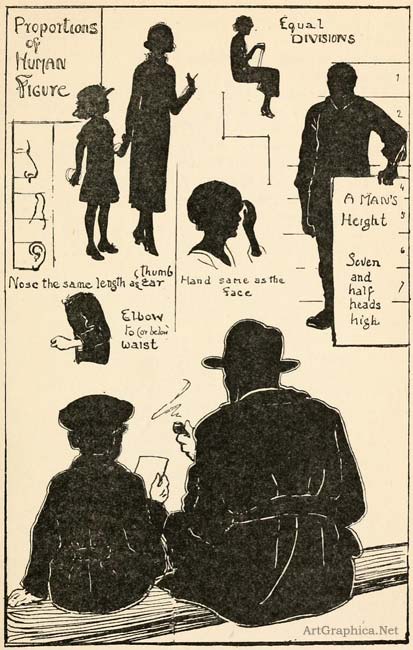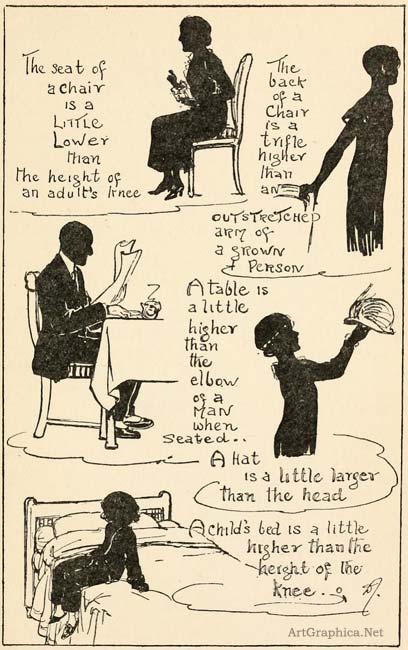Drawing for Beginners
CHAPTER VII
Drawing People in the Right Proportions
WHEN first we draw human beings we are very much inclined to draw the child and the man in the same proportions. Indeed, it is a mistake we invariably commit.
We draw a tall man with long legs and swinging arms, and we draw at his side a little man with short striding legs and swinging arms. We label the tall man ' father,' and the little man ' son.'
But they are not a man and a child, they are merely a man and a smaller man. Sometimes we have an uncomfortable feeling that our children do not look very childish, and we complain in discouragement : " I can't make my little boy look like a boy ! "
It would seem perfectly logical to draw children as little people, and yet, if we pause to reflect, is it really so ?
As a kitten is different from a cat, a chick from a hen, so must a child be different from a man.
Have you ever remarked to yourself the huge size of Baby's head in comparison with his body ?
Though the head is large, the features are almost negligible, the tiny neck is a mere roll of fat. Baby has a large round eye, a flat wide nostril, a button of a nose, and a half-open, flower-like mouth. (See Fig. 32.)
The months and the years slowly pass, Baby's features form, his head develops, his body grows, his limbs extend.
Compare the photographs of Pamela at one year and Pamela at twelve years ; and look well at Pamela when she trips beside her aunt.
If we draw Martin and his father sitting side by side on a bench watching a football-match, in all probability we should draw a big man, and at his side a little man less than half his size. Martin may inherit the square shape of his father's shoulders, but they will be less than half in bulk. The thick, strong, muscular neck of Martin's father is very different from Martin's thin weedy little one. The head of the man is well shaped and firmly balanced, but the boy's will probably look very large, a trifle bumpy and big behind the ears. The ears of Martin's father lie flat against his close-cropped hair, whereas Martin's stick out from his thin jaws and neck like little handles on a big vase. Martin's legs are thin and lacking in calf, his feet consequently appear rather too large for his height ; but his father's legs are finely shaped, muscular, and well proportioned.
Now having considered these few points, would you still feel inclined to draw Martin and his father with the same proportions ?
There are a few accepted rules that are useful to remember, though we must never blindly follow any rules, for we know the human figure is capable of every variety of form. Still, as a check to an observation that cannot always be correct, as a trifling guide when perplexing moments beset us, these facts are worth noting.
A grown man of good proportion, when standing erect, usually measures seven and a half heads high. Remember, however, that this is the proportion of a perfectly formed man. A very, very tall man would not have an elongated body, but longer legs. The bodies of most men are the same length. A man when standing with his arms to his sides will rest the tips of his fingers a little more than half-way between his hips and knees.
A figure when sitting roughly represents three lines of a fairly equal length, measuring from the nape of the neck to the seat, from the seat to the knee, from the knee to the foot.
An elbow usually rests in the hollow below the waist, as you can prove for yourself by clapping your arms to your side.
A hand measures the same length as the face. Put the palm of your hand against your chin and spread your fingers upward.
A nose is the same length as a thumb. The ear the same length as a nose.
And, having gleaned these few ordinarily accepted rules, you will probably find your next model will have arms too long, legs too short, and a nose disagreeing most profoundly with the length of the thumb. Nature is a law unto itself, and I bring these few suggestions to you with some misgivings.
If your eye insists that your model measures but five heads high, accept that as a fact. Very few human beings are correctly proportioned.

Fig. 33. PROPORTIONS OF THE HUMAN FIGURE
CHAPTER VIII
HOUSES, hats, motor-cars, chairs, beds, and boats-- all these and many other inanimate things are fruitful of much worry for the young and inexperienced artist.
" Why is it," we ask ourselves, " that the hat of the man in my drawing does not look as if it would fit on his head ? How can I make it right ? "
And the reply comes, " Measure--measure the size of the hat against the size of the man's head."
It may be that the hat is held in the man's hand, or that it rests against his chair, in which case measure the size of the hat with your pencil and put the measurement against the man's head. In all probability you have committed the very usual mistake of making the hat too small for the head.
Hats are not as easy to draw as some young artists seem to believe. The depth and width of the hat can be the most deceiving and perplexing problem.
Personally I never hesitate to measure hats most carefully against the heads of the owners.
Tall hats are more than usually difficult, and consequently more often than not wrongly depicted. The term ' tall ' is, to begin with, a misnomer. In the old days of rough high beavers and curled brims the words ' tall ' or ' high ' were quite appropriate. But nowadays it is not so, as you can prove for yourself by placing a tall hat against another object, and checking its height ; for instance, against the leg of a dining-room chair. You will find that the hat barely reaches the first rail of the front leg. Which brings under our consideration ordinary chairs, queer enough looking affairs in our early drawings, represented with very small (and always unpadded) seats, perched on long, crooked, and stilt-like legs.
The seat of a chair is a little lower than an adult's knee. How uncomfortable it would be were it otherwise ! And the back of the chair (I refer to the ordinary dining-room chair) lies half-way between the knee and the hip, and level with the outstretched hand of a grown person of average height. Ask your mother, father, or big brother to stand for a second by a chair and check these proportions for yourself. The height of a dining-room table is higher, but only a little higher than the height of a seated man's elbow. An inexperienced artist is inclined to draw the table far too high. And a table either too high or too low would complicate matters pretty considerably for the diner.
A chair is an interesting subject to draw. Even the roughest and most primitive has good lines and a certain grace. First sketch the skeleton shape, the seat and the four legs, as you would a box, by drawing lines from point to point. This will enable you to get a clear idea of the perspective. Then compare the curves of the back legs with those of the front, carry the curve from the legs up to the back, and add the arms.
Chairs there are of every description, lounge-chairs, and chairs fashioned out of all kinds of materials. When chairs are given for tests in drawing examinations they are usually the simple wooden or Windsor chairs, and if you should feel inspired to try your hand in this direction, add something of an outside interest, a velvet or silk cushion, a fur stole or a woollen scarf ; or, better still, persuade Pussy to lie curled upon the seat. Then you will have several kinds of textures. Couches, settees, and sofas are often under-represented in our sketches. They are really very large objects, and made to hold a grown person when lying full length.
Beds, too, are commonly shorn of half their width and length. A bed, even a small one, occupies a good deal of space. If we err over the length and width, we are on the other hand very prone to draw beds a great deal too high from the ground. The old-fashioned four-poster with its curtains and plumes belongs to a bygone age. The bed of to-day is usually low and lightly framed. Would it not be extremely awkward if it were higher ? We should certainly require a ladder to climb into the beds depicted in the drawings of many young artists.

Fig. 34. THE PROPORTIONS OF CHAIRS, TABLES, HATS, BEDS
When drawing tables, couches, or beds make a point of first drawing the framework, the long seats of the sofas, the legs, and then the backs and the arms. Tables fall naturally into simple forms with the top first decided, and then the angle of the legs. Suggest the length, width, and height of the bed, adding afterward minor details of sheets, blankets, pillows, and counterpane.
Boats we rarely draw large enough to hold the crew, let alone the passengers ; motor-cars are usually depicted far too small for their owners.
Heads, faces, and shoulders emerge happily enough from the tops of cars, carriages, and boats, but it is often in the nature of a conundrum to find accommodation for the unfortunate bodies and legs. Therefore, always draw these hidden limbs, for even if you make mistakes with shapes and proportions, the mere fact of sketching bodies and legs will serve to remind you that a certain space is required ; and they can be erased as you proceed with your drawings.
Another difficulty that besets us is the matter of spacing the floors of the houses, the windows, and doorways. Tenants are often seen strolling about their front lawns, and the houses in the background have windows so closely presented that nothing larger than a well-proportioned mouse could possibly move in the rooms. Yet a room, even a small room, is a considerable height. Your father does not knock his head against the ceiling. He stands erect, and there is ample space above his head. Try to remember that the gentleman and lady require rooms large enough to use. This matter of drawing inanimate things in proportion is chiefly a matter of common sense. Leave sufficient space between
each window so that the floors are not crammed closely together and the windows are drawn fairly evenly. Reflect how uncomfortable it would be to live behind windows sprinkled haphazard about the front of the house !
If we apply a good deal of common sense, and compare the size and shape of one thing with another, we shall find the difficulties of drawing inanimate things gradually fading away.
Prev Page
Drawing the face
|










